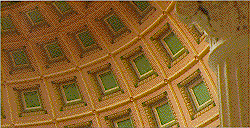|
The Second Empire style originated in Europe, where it first appeared
during the rebuilding of Paris in the 1850s and 60s. Based upon French
Renaissance prototypes, such as the Louvre Palace, the Second Empire
style is characterized by the use of a steep mansard roof, central and
terminal pavillions, and an elaborately sculptured facade. Its
sophistication appealed to visiting foreigners, especially in England and
America, where as early as the late 1850s, architects began adopting
isolated features and, eventually, the style as a coherent whole. Alfred
Mullett's interpretation of the French Second Empire style was, however,
particularly Americanized in its lack of an ornate sculptural programme
and its bold, linear details.
While it was only a project on the drafting table, the design of the OEOB
was subject to controversy. When it was completed in 1888, the Second
Empire style had fallen from favor, and Mullett's masterpiece was
perceived by capricious Victorians as only an embarrassing reminder of
past whims in architectural preference. This was especially the case
with the OEOB, since previous plans for a building on the same site had
been in the Greek Revivial style of the Treasury Building.
In 1917, the Commission of Fine Arts requested John Russell Pope to
prepare sketches of the State, War, and Navy building that incorporated
Classical facades. Duringe the same year, Washington architect Waddy B.
Wood completed a drawing depicting the building remodeled to resemble the
Treasury Building. This project was revived in 1930, but funds were cut,
due to opposition to the project and financial burdens imposed by the
Great Depression. In 1957, President Eisenhower's Advisory Committee on
Presidential Office Space recommended demolition of the Executive Office
Building and construction of a modern office facility. However, the
overwhelming expenses associated with the demolition saved the building.

North wing dome. Paint analysis revealed differences in coloration
corresponding to the differences in design in the two pairs of domes and
led to their restoration in 1984.
(Walter Smalling, Jr.)
|

